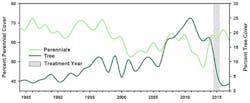Technology Revolutionizes Rangeland Monitoring
The Rangeland Analysis Platform (RAP) provides the first-ever vegetation cover maps for rangelands from the Great Plains to the Pacific Ocean.
Created by the University of Montana in partnership with USDA and U.S. Department of Interior (DOI), this easy-to-use technology provides trends in rangeland resources from 1984 to present at the ranch, county, and watershed scales.
“I’ve waited my whole career for this kind of tool,” says Shane Green, USDA Natural Resources Conservation Service (NRCS) range management specialist in Utah. “It provides the context for landscape planning that’s been lacking in the rangeland profession.”
The RAP revolutionizes monitoring because it provides a view of rangeland resources at an unprecedented blend of time, space, and scale. This is accomplished through field data, satellite imagery, and the cloud-based computing power of Google Earth Engine.
“By working with Google, we harnessed decades of satellite imagery, trained it with on-the-ground field data, and put it at the fingertips of practitioners,” said Brady Allred, the app’s creator and professor of rangeland ecology at the University of Montana.
The app relies on over 30,000 field plots collected by NRCS’ National Resources Inventory and the Bureau of Land Management’s Assessment, Inventory, and Monitoring datasets. The maps and charts produced by RAP, coupled with site-specific knowledge, provide a powerful tool for improving grazing land resources.
Green added: “Tracking changes in vegetation across entire ranches for the past 30 years gives me a new perspective of what is happening. I no longer have to rely on small sporadic snapshots.”
Spanning the entire west, the RAP encompasses regional differences. For example, the app can identify where to reduce woody encroachment in the Great Plains, evaluate effectiveness of cheatgrass treatments in the Great Basin, and help people visualize the impacts of drought across the Southwest.
“Alongside information collected on the ground, the platform’s aerial view of vegetation through time opens new doors for conservation and scientific monitoring,” said Jeremy Maestas, an ecologist with NRCS. “This app empowers ranchers and resource managers to plan actions that improve rangelands.”
This new technology helps NRCS meet its goals for partnering with private landowners to conserve rangelands. Since 2010, NRCS Working Lands for Wildlife has helped over 2,000 ranchers restore and protect more than 7.5 million acres of grazing lands.
The app is available for free at rangelands.app.

